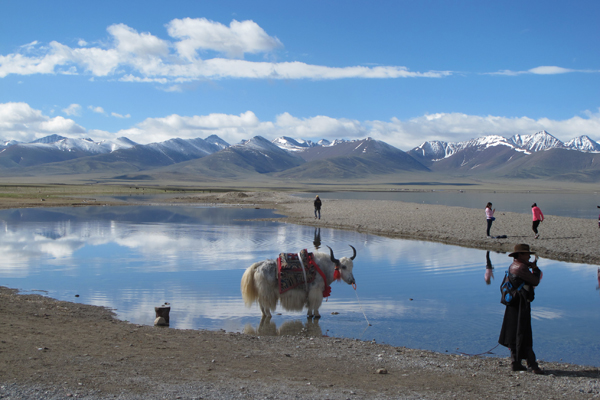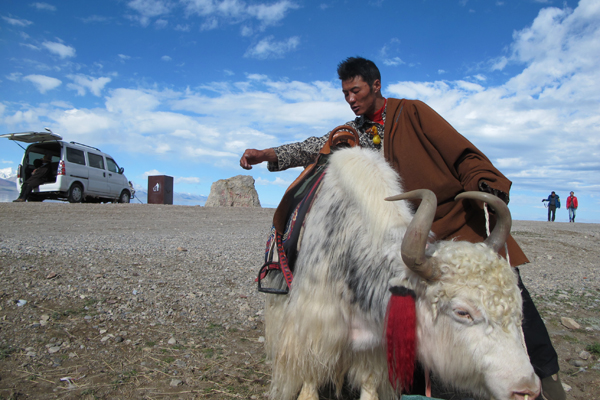Nomads on the plateau in the Tibet autonomous region boost their incomes and living standards by offering trips on one of the area's most-recognizable symbols.
As the first rays of the morning sun on the plateau were pouring onto the snow-capped mountains around Namtso Lake in the Tibet autonomous region, Yontan headed to the sacred lake with his beloved white yak.
Like many of his fellow nomads around the lake, Yontan runs a business on the lakefront during the peak summer tourist season, earning a living by allowing visitors to ride his yak.
Yontan has been engaged in the business for five years, and his sun-tanned brown face amply demonstrates that living and working at an attitude of almost 5,000 meters is not easy.
"So far this year, we have had fewer tourists than last year. I hope more will arrive in July and August," he said.
The 25-year-old said guests used to arrive for yak rides at about 9:30 am, but this year no one has turned up before 11 am.
Namtso Lake is renowned as one of the most beautiful tourist destinations in Tibet, and its spiritual sites have attracted Buddhist pilgrims for centuries.
Standing at an elevation of 4,718 meters, the lake has a surface area of 1,920 kilometers, making it the second-largest body of water in Tibet.
Every year, thousands of domestic and overseas tourists explore the lake, which has become a major source of the region's tourist revenue. The local people have seen its popularity as an opportunity to raise their own incomes.
"We earn a stable income by herding yaks and sheep, and we see yak-riding as an opportunity for part-time work in the summer," Yontan said.
Although they are found across the Himalyan region, the Yak is a symbol of the Tibetan plateau. Most tourists are excited to see the animals, and want to experience the feeling of sitting on their backs.
Born with distinctive beautiful horns, Yontan's yak always attracts a larege number of tourists, especially Tibetans.
Tourists ride the yak into the lake to take photos, and also amble along the lakeshore, with Yontan firmly holding the reins.
"Riding the yak once costs 30 yuan ($5) to 35 yuan," said Yontan, adding that last year he earned 20,000 yuan from the trade.
Yontan's yak generates half of the family's annual income, and he spends many hours with the animal every day.
Raising a rideable yak is hard work and also expensive, because the animals require plenty of forage, such as grass, flour and beans.
"More than 10,000 yuan has to be spent every year to raise a rideable yak, and a lot of hard work is required to take care of them," Yontan said.
Nearly 40 nomads on the lakefront operate yak-riding businesses, while about 90 own horse-riding businesses.
Some of the nomads own two or three "riding yaks", but Yontan just has one.
Compared with herding yaks and sheep on the grassland, the nomads consider yak-riding as a source of extra income, even though the work is not stable.
In addition to yak-riding, many nomads around the lake are engaged in tourism, in businesses such as horse-riding, selling tourist goods, and running shops, guest houses and restaurants.
|
 A nomad runs a yak-riding business on the lakefront during the peak summer tourist season. Palden Nyima / China Daily |
|
 Yontan, who runs a yak-riding business on the banks of Namtso Lake, saddles up one of his white yaks. Palden Nyima / China Daily |